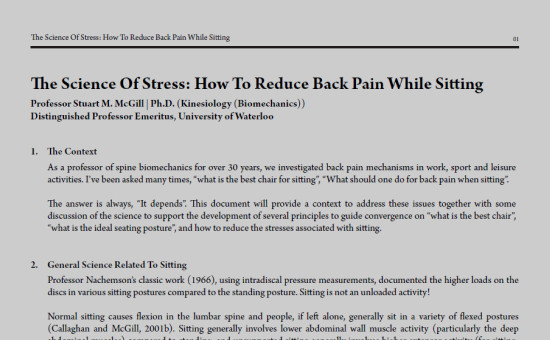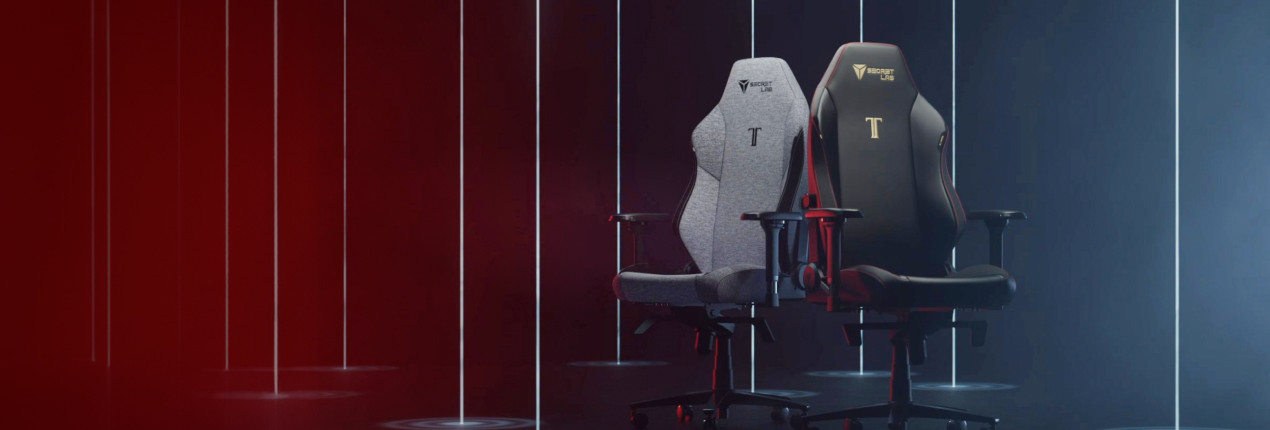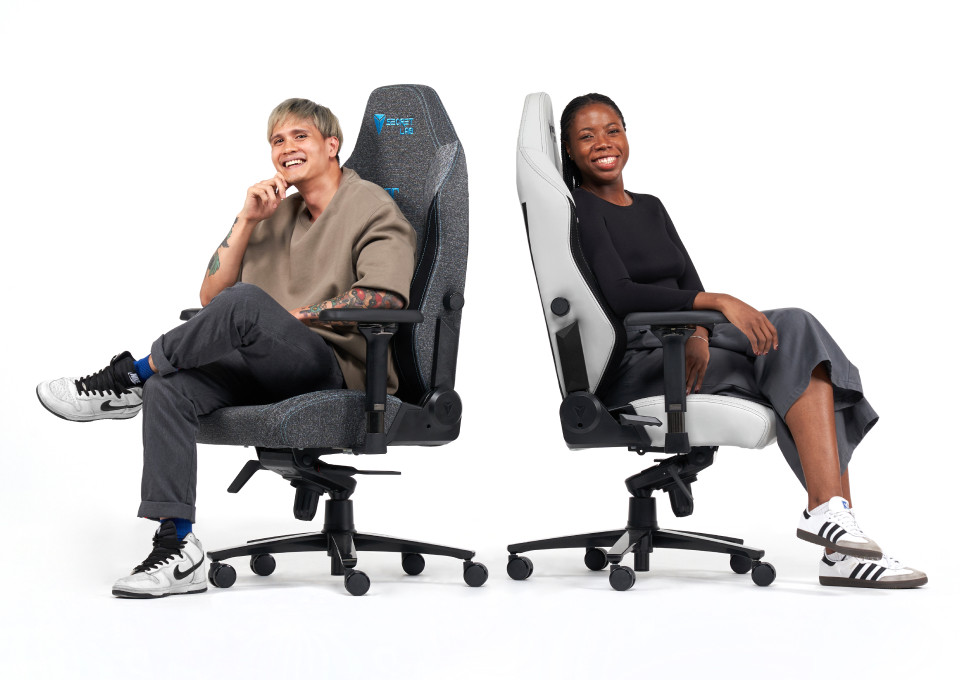It’s 2025.
No one should buy a chair designed for just one task.
Most ergonomic chairs today are still based on design theories that have been outdated since the 21st century.
With their origins in the 1970s, they were created for one single purpose — and one single posture. Working at typewriters. Or hunched over paperwork.

Today, we’re doing so much more.
From video calls to gaming, streaming Netflix, playing the guitar, texting, and even napping, we spend over 12 hours a day seated in front of our desks.
A good chair should never place any limits on posture changes. Thoughtful ergonomic design lets you switch between multiple activities and change postures effortlessly, so you can do it all.
A modern approach to ergonomic design
Ergonomic support for multiple activities.
Across any posture.
The idea of support for multiple postures and activities is at the heart of every Secretlab chair. Our ergonomic chairs let you adopt the most optimal posture for the task at hand, whether it’s sitting upright, cross-legged, or in full recline.
Secretlab chairs were originally designed for the most demanding professional gamers who spent over 16 hours a day seated. But the myriad design decisions and ergonomic refinements we obsessed over will benefit anyone who spends long hours seated at their desk.
The Secretlab TITAN Evo has since found its way into the homes of over 3 million users worldwide, many of them non-gamers.

Stress migration theory
“The best posture is your next posture.”
- Professor Stuart M. McGill
- Ph.D. (Kinesiology (Biomechanics))
- Distinguished Professor Emeritus, University of Waterloo
When you spend over 12 hours a day seated in the same position, no matter how optimal, stress builds up on your body.
Movement is crucial to relieving this strain.
TITAN Evo is designed to promote natural posture changes and movement.
We also take care to ensure every element of TITAN Evo is quick and easy to adjust. Our tilt, height, and recline adjustments are intuitively positioned within arm’s reach. You can effortlessly change your posture throughout the day as you switch between activities and move freely.
4D armrests
Fully adjustable in four directions
Multi-tilt mechanism
Lockable tilt angle
Backrest recline
Full 165° of angle adjustments
4-way L-ADAPT™ Lumbar Support System
Moves up, down, in, and out
Magnetic Memory Foam Head Pillow
Magnetically adjustable by 155mm
Re-engineered Class 4 hydraulics
Adjustable range of 100mm
Certified by US Ergonomics
The Secretlab TITAN Evo is certified by United States Ergonomics to provide measurable ergonomic benefits to the user by improving comfort and fit and minimizing risk factors that may cause injuries. United States Ergonomics certification indicates that leading experts in the field of ergonomics back TITAN Evo.
Experts have subjected TITAN Evo to rigorous, objective tests in adherence to guidelines established by the International Ergonomics Association. This ensures it meets or exceeds standards derived from published literature and principles of ergonomics, biomechanics, and human factors.
Patent-pending cold-cure foam
Why we choose foam over mesh
Most ergonomic task chairs are constructed from mesh. Because for years, mesh was thought to be superior. But recent research has shown that carefully engineered foam can outperform mesh.
Recent research by the University of California, Berkeley suggests no significant differences between the two in key areas such as comfort, discomfort, pain, and fatigue.
In fact, foam was found to have some unique advantages. When engineered properly, foam edges out mesh in terms of pressure distribution and relief.
The Berkeley researchers also found that foam was reported to be significantly more supportive over time, suggesting that it is more suitable for long hours of sitting — a crucial factor for gamers, creators, professionals, and anyone looking for a good chair.
That’s why the Secretlab TITAN Evo employs a high-density foam mix. Our patent-pending cold-cure foam is deliberately engineered to be medium-firm, for the perfect blend of comfort and performance.

Every detail matters
How we obsessively design for comfort throughout your 12-hour days
When you sit on a Secretlab chair, you’re feeling the hundreds of tiny design decisions that we obsessed over, again and again.
From the deliberately sculpted backrest that follows the horizontal curve of your shoulders to our lumbar system’s Y-shaped lattice of living hinges that intelligently adapts to your movements, every single detail on the Secretlab TITAN Evo comes together to make a big difference.
Hours of R&D
25,000+
Number of prototypes
932
Hours spent on testing
50,000+
Secretlab Ergonomics Advisory Board
Our Ergonomics Advisory Board of independent experts works with our engineers on detailed ergonomic studies and product development reviews. So our designs always incorporate the latest technologies in ergonomic science.


“For better ergonomic health, your body should be moving frequently, even when seated. Variability of posture is more important than maintaining 'perfect posture.'”
Dr. Jordan TsaiBoard Certified Orthopedic Clinical SpecialistEsports Physical TherapistFounder of Respawn Therapy

“Constant changes to your sitting posture are integral to healthy sitting. Avoid a seat that keeps you locked in a single sitting posture.”
Dr. Lindsey MiglioreEsports Medicine and PM&R PhysicianFounder of GamerDoc

“I use the Secretlab TITAN Evo chair daily when I work. We should never restrict ourselves to a particular sitting position — no matter how optimal — for long hours.”
Dr. James GohPhD of Bioengineering and Biomedical EngineeringEmeritus Professor, National University of Singapore

“For better ergonomic health, your body should be moving frequently, even when seated. Variability of posture is more important than maintaining 'perfect posture.'”
Dr. Jordan TsaiBoard Certified Orthopedic Clinical SpecialistEsports Physical TherapistFounder of Respawn Therapy

“Constant changes to your sitting posture are integral to healthy sitting. Avoid a seat that keeps you locked in a single sitting posture.”
Dr. Lindsey MiglioreEsports Medicine and PM&R PhysicianFounder of GamerDoc

“I use the Secretlab TITAN Evo chair daily when I work. We should never restrict ourselves to a particular sitting position — no matter how optimal — for long hours.”
Dr. James GohPhD of Bioengineering and Biomedical EngineeringEmeritus Professor, National University of Singapore
Research journals
Our team works with leading ergonomic laboratories and research institutions to validate our designs through extensive user testing. Explore the science and research in the fields of biomechanics, ergonomic design, human factors engineering, and more.
Impact of Seat Material on Comfort, Preference and Performance During Computer-Based Tasks over a Prolonged Bout of Sitting
University of California, Berkeley
Abstract Prolonged sitting time is associated with negative health outcomes, including physical discomfort. Chair design affects seat posture, micro-movement, and pressure distribution, which impacts the user experience. This study investigated the impact of mesh versus foam material on comfort, preference, and subjective performance. Two chairs were used over a three-hour bout of sitting on two different days. Analysis showed no significant difference in pain, comfort, discomfort, or fatigue between chairs, but pain increased in both chairs during the last hour of sitting. The foam chair felt more supportive than the mesh chair at the end of the test period, while more participants preferred the mesh seat material overall.
Conclusion The overall results indicate that there was not a substantial difference in user experience during a long bout of sitting in chairs of foam or mesh material.

University of California, Berkeley
Human Factors and Ergonomics Program
Consistently ranked among the four top research universities in the world, UC Berkeley’s world-class faculty and researchers lead the way in pushing the boundaries in their respective fields. Its Human Factors and Ergonomics Program consists of consultants who are Board Certified Professional Ergonomists (CPEs) with decades of practical consulting experience.

Afterman, M., Houghton, F., Honan, M., Barr, A., & Harris-Adamson, C.
https://doi.org/10.1177/1071181322661483Development and Validation of Neuroscience-based Human Factors and Ergonomic Assessment Methodologies for Measurement of the Impact of Seating System Design on Video Gameplay Performance
Mauro Usability Science
Abstract The MUS/Secretlab eSports Neuroscience-Based Human Factors Optimization Lab combines physical workstation configuration testing with live gameplay performance to allow detailed scientific analysis of the relationship between workstation design and game design attributes, as they impact longitudinal gameplay performance, user comfort, and subjective experience of users. The testing system enables tracking of critical human factors variables, with a focus on cognitive/physical workload, fatigue, skill acquisition, stress, and video gameplay performance.The validation study demonstrated that seating system does impact gameplay performance and experience in critical and statistically significant ways. The validation study confirmed that an ergonomically optimized seating system can yield clear performance benefits in terms of video gaming key performance indicator metrics, objective chair motion and body motion variables, eye-tracking variables related to cognitive processing of gaming stimuli, as well as improved comfort and satisfaction with overall gaming experience for longer durations of play.
Conclusion The Secretlab TITAN Evo chair tested yielded a clear ergonomic benefit in terms of gameplay performance and subjective gaming experience compared to the Herman Miller Aeron chair.

Charles Mauro
Founder and President of Mauro Usability Science
Selected by the Human Factors and Ergonomics Society as a “Titan of Industry” for Human Factors research, Charles Mauro is a pioneer in neuroscience-based design research focused on UX optimization and usability for complex products and services. His clients include Nike, Dyson, Apple, Microsoft, Goldman Sachs, Pfizer, Amazon, Facebook, and more.

The Effect of TITAN Evo Chairs on Muscle Stiffness, Player Perception and Performance
New York Institute of Technology, Center for Sports Medicine
Abstract The purpose of this study is to examine the difference of an Aeron chair and a TITAN Evo chair on muscle stiffness, gaming performance, and gamers perceptions during a 2-hour League of Legends gaming session. Prior to gaming, subjects sat for 15 minutes in the chair. Dynamic muscle stiffness [N/m] was tested using oscillation frequency [Hz]. Measurements were taken bilaterally on the upper trapezius, mid trapezius, lower trapezius and erector spinae muscles pre and post 2 hours of gameplay. Surveys were administered following each day on chair preference. Total Wins and Kills were recorded. A paired t-test was used to compare the difference in muscle stiffness pre- and post-game play between chairs and for wins and kills, as well as descriptive statistics.
Conclusion This study found minimal differences in muscle stiffness between the TITAN Evo chair and the Aeron chair. However, the data suggests that the TITAN Evo chair is the preferred choice among this group of gamers and is associated with enhanced performance.

New York Institute of Technology
The New York Institute of Technology's Center for Esports Medicine is breaking new ground in esports performance and medicine, working closely with esports athletes who have to grapple with a set of unique medical problems. The center’s medical professionals, including physical and occupational therapists, work to ensure that esports athletes are given the same care and attention as traditional athletes, helping to optimize performance, improve health and wellness, and keep players injury-free so they can go on to have longer and more fulfilling careers.

Scott, E., Zwibel, H., Werner, W.G., & DiFranciso-Donoghue, J.
https://digitalcommons.wku.edu/ijesab/vol15/iss3/5The Impact of Chair Design on Trunk Sway Parameters During Computer-based Tasks Over a Prolonged Bout of Sitting
University of California, Berkeley
Abstract Prolonged sedentary behavior has increased due to computer use for work and leisure activities. Prolonged bouts of sitting have been associated with health risks such as low back pain. This study investigated how armrest position and tilt mechanism impact user-chair interfacial pressure and micromotion. Overall, the findings indicate that proper armrest adjustment may increase both the magnitude and the frequency of micromovements while sitting, which could help reduce or prevent lower back pain during sedentary behavior.
Conclusion Adjusting armrests according to established ergonomic guidelines increases micromotion that may be helpful in reducing low back pain associated with sitting.

University of California, Berkeley
Human Factors and Ergonomics Program
Consistently ranked among the four top research universities in the world, UC Berkeley’s world-class faculty and researchers lead the way in pushing the boundaries in their respective fields. Its Human Factors and Ergonomics Program consists of consultants who are Board Certified Professional Ergonomists (CPEs) with decades of practical consulting experience.

Houghton, F., Afterman, M., Honan, M., Barr, A., & Harris-Adamson, C.
https://doi.org/10.1177/1071181322661350Impact of Seat Material on Comfort, Preference and Performance During Computer-Based Tasks over a Prolonged Bout of Sitting
University of California, Berkeley
Abstract Prolonged sitting time is associated with negative health outcomes, including physical discomfort. Chair design affects seat posture, micro-movement, and pressure distribution, which impacts the user experience. This study investigated the impact of mesh versus foam material on comfort, preference, and subjective performance. Two chairs were used over a three-hour bout of sitting on two different days. Analysis showed no significant difference in pain, comfort, discomfort, or fatigue between chairs, but pain increased in both chairs during the last hour of sitting. The foam chair felt more supportive than the mesh chair at the end of the test period, while more participants preferred the mesh seat material overall.
Conclusion The overall results indicate that there was not a substantial difference in user experience during a long bout of sitting in chairs of foam or mesh material.

University of California, Berkeley
Human Factors and Ergonomics Program
Consistently ranked among the four top research universities in the world, UC Berkeley’s world-class faculty and researchers lead the way in pushing the boundaries in their respective fields. Its Human Factors and Ergonomics Program consists of consultants who are Board Certified Professional Ergonomists (CPEs) with decades of practical consulting experience.

Afterman, M., Houghton, F., Honan, M., Barr, A., & Harris-Adamson, C.
https://doi.org/10.1177/1071181322661483Development and Validation of Neuroscience-based Human Factors and Ergonomic Assessment Methodologies for Measurement of the Impact of Seating System Design on Video Gameplay Performance
Mauro Usability Science
Abstract The MUS/Secretlab eSports Neuroscience-Based Human Factors Optimization Lab combines physical workstation configuration testing with live gameplay performance to allow detailed scientific analysis of the relationship between workstation design and game design attributes, as they impact longitudinal gameplay performance, user comfort, and subjective experience of users. The testing system enables tracking of critical human factors variables, with a focus on cognitive/physical workload, fatigue, skill acquisition, stress, and video gameplay performance.The validation study demonstrated that seating system does impact gameplay performance and experience in critical and statistically significant ways. The validation study confirmed that an ergonomically optimized seating system can yield clear performance benefits in terms of video gaming key performance indicator metrics, objective chair motion and body motion variables, eye-tracking variables related to cognitive processing of gaming stimuli, as well as improved comfort and satisfaction with overall gaming experience for longer durations of play.
Conclusion The Secretlab TITAN Evo chair tested yielded a clear ergonomic benefit in terms of gameplay performance and subjective gaming experience compared to the Herman Miller Aeron chair.

Charles Mauro
Founder and President of Mauro Usability Science
Selected by the Human Factors and Ergonomics Society as a “Titan of Industry” for Human Factors research, Charles Mauro is a pioneer in neuroscience-based design research focused on UX optimization and usability for complex products and services. His clients include Nike, Dyson, Apple, Microsoft, Goldman Sachs, Pfizer, Amazon, Facebook, and more.

The Effect of TITAN Evo Chairs on Muscle Stiffness, Player Perception and Performance
New York Institute of Technology, Center for Sports Medicine
Abstract The purpose of this study is to examine the difference of an Aeron chair and a TITAN Evo chair on muscle stiffness, gaming performance, and gamers perceptions during a 2-hour League of Legends gaming session. Prior to gaming, subjects sat for 15 minutes in the chair. Dynamic muscle stiffness [N/m] was tested using oscillation frequency [Hz]. Measurements were taken bilaterally on the upper trapezius, mid trapezius, lower trapezius and erector spinae muscles pre and post 2 hours of gameplay. Surveys were administered following each day on chair preference. Total Wins and Kills were recorded. A paired t-test was used to compare the difference in muscle stiffness pre- and post-game play between chairs and for wins and kills, as well as descriptive statistics.
Conclusion This study found minimal differences in muscle stiffness between the TITAN Evo chair and the Aeron chair. However, the data suggests that the TITAN Evo chair is the preferred choice among this group of gamers and is associated with enhanced performance.

New York Institute of Technology
The New York Institute of Technology's Center for Esports Medicine is breaking new ground in esports performance and medicine, working closely with esports athletes who have to grapple with a set of unique medical problems. The center’s medical professionals, including physical and occupational therapists, work to ensure that esports athletes are given the same care and attention as traditional athletes, helping to optimize performance, improve health and wellness, and keep players injury-free so they can go on to have longer and more fulfilling careers.

Scott, E., Zwibel, H., Werner, W.G., & DiFranciso-Donoghue, J.
https://digitalcommons.wku.edu/ijesab/vol15/iss3/5The Impact of Chair Design on Trunk Sway Parameters During Computer-based Tasks Over a Prolonged Bout of Sitting
University of California, Berkeley
Abstract Prolonged sedentary behavior has increased due to computer use for work and leisure activities. Prolonged bouts of sitting have been associated with health risks such as low back pain. This study investigated how armrest position and tilt mechanism impact user-chair interfacial pressure and micromotion. Overall, the findings indicate that proper armrest adjustment may increase both the magnitude and the frequency of micromovements while sitting, which could help reduce or prevent lower back pain during sedentary behavior.
Conclusion Adjusting armrests according to established ergonomic guidelines increases micromotion that may be helpful in reducing low back pain associated with sitting.

University of California, Berkeley
Human Factors and Ergonomics Program
Consistently ranked among the four top research universities in the world, UC Berkeley’s world-class faculty and researchers lead the way in pushing the boundaries in their respective fields. Its Human Factors and Ergonomics Program consists of consultants who are Board Certified Professional Ergonomists (CPEs) with decades of practical consulting experience.

Houghton, F., Afterman, M., Honan, M., Barr, A., & Harris-Adamson, C.
https://doi.org/10.1177/1071181322661350Whitepapers
Every Secretlab chair is grounded in research into the mechanisms of back pain and how people move in their seats throughout the day. Dive into the details behind science-backed ergonomic design and how a good chair should adapt to support you.
The science of stress: How to reduce back pain while sitting


AbstractThis paper aims to address the mechanisms of back pain, what one should do for back pain while sitting, and the ideal sitting posture. As it turns out, there is no ideal sitting posture given the variance in body types, past injury, and pain history. The optimal sitting posture is one that continually changes. To that end, a good chair should not be task-specific and must support you across multiple tasks, including watching television, gaming, business meetings, and more.
The science of stress: How to reduce back pain while sitting
Professor Stuart M. McGill
Ph.D. (Kinesiology (Biomechanics))Distinguished Professor Emeritus, University of Waterloo
Ergonomic considerations: What makes a “good” gaming chair?


AbstractPain while gaming is incredibly prevalent, with 42% of collegiate esports athletes experiencing neck and back discomfort. Ergonomics addresses this concern by applying the science of design to ensure a comfortable, pain-free gaming experience. Seats made out of foam significantly decrease the pressure exerted on the body. Furthermore, chairs with lumbar support and adjustable armrests lead to greater comfort and an improved experience overall.
Ergonomic considerations: What makes a “good” gaming chair?
Dr. Lindsey Migliore
Esports Medicine and PM&R PhysicianFounder of GamerDoc
Promoting movement: An adjustable seat for good sitting ergonomics


AbstractWith more people adopting a sedentary lifestyle, there is a growing need to analyze whether their chairs are aiding them in achieving good sitting ergonomics. A well-designed chair should be equipped to adjust to users of diverse body types and sitting habits, across a variety of tasks. A dynamic sitting posture alleviates pressure on your body and reduces the risk of musculoskeletal disorders.
Promoting movement: An adjustable seat for good sitting ergonomics
Download PDFThe science of stress: How to reduce back pain while sitting


AbstractThis paper aims to address the mechanisms of back pain, what one should do for back pain while sitting, and the ideal sitting posture. As it turns out, there is no ideal sitting posture given the variance in body types, past injury, and pain history. The optimal sitting posture is one that continually changes. To that end, a good chair should not be task-specific and must support you across multiple tasks, including watching television, gaming, business meetings, and more.
The science of stress: How to reduce back pain while sitting
Professor Stuart M. McGill
Ph.D. (Kinesiology (Biomechanics))Distinguished Professor Emeritus, University of Waterloo
Ergonomic considerations: What makes a “good” gaming chair?


AbstractPain while gaming is incredibly prevalent, with 42% of collegiate esports athletes experiencing neck and back discomfort. Ergonomics addresses this concern by applying the science of design to ensure a comfortable, pain-free gaming experience. Seats made out of foam significantly decrease the pressure exerted on the body. Furthermore, chairs with lumbar support and adjustable armrests lead to greater comfort and an improved experience overall.
Ergonomic considerations: What makes a “good” gaming chair?
Dr. Lindsey Migliore
Esports Medicine and PM&R PhysicianFounder of GamerDoc
Promoting movement: An adjustable seat for good sitting ergonomics


AbstractWith more people adopting a sedentary lifestyle, there is a growing need to analyze whether their chairs are aiding them in achieving good sitting ergonomics. A well-designed chair should be equipped to adjust to users of diverse body types and sitting habits, across a variety of tasks. A dynamic sitting posture alleviates pressure on your body and reduces the risk of musculoskeletal disorders.
Promoting movement: An adjustable seat for good sitting ergonomics
Download PDFEngineered for today's gamer, creator, and hybrid worker
Explore how every element of the Secretlab TITAN Evo is designed to support you across everything you do.

One chair. Three sizes.
Find the perfect fit

Proprietary pebble seat base
The support you need with the freedom to move

Full-length ergonomic backrest
Intentionally sculpted to follow the natural horizontal curve of your shoulders

L-ADAPT™ lumbar support system
Personalized support for your lower back


SECRETLAB TITAN EVO
Our flagship ergonomic chair. Engineered for unmatched comfort and deeper personalization.
Shop Now
Sit. Stand. Move. Complete your setup with MAGNUS Pro.
The ultimate sit-to-stand desk to bring movement back into your space.
Learn MoreFrom the founder
“It’s time to move beyond what a traditional chair can do. In 2025, no one should buy a computer chair that only allows them to do one thing. In fact, sitting upright in the same posture for 12 hours is just wrong.”
Ian Alexander AngCo-founder & CEO, Secretlab











